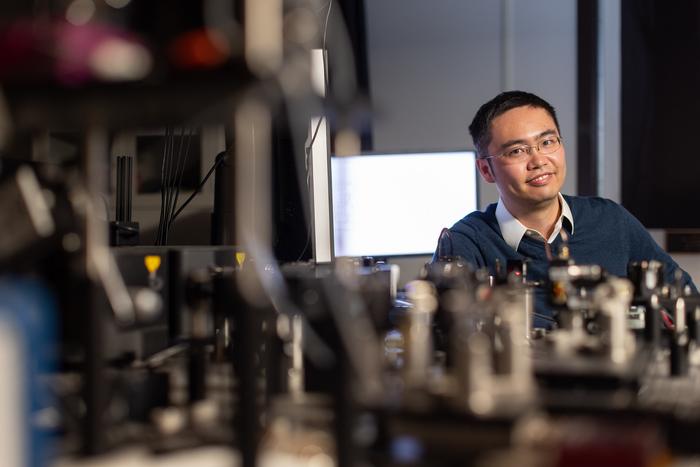The realm of experimental physical chemistry is witnessing a remarkable shift with the recognition of innovative research by young scientists. At the forefront of this evolution is Xiaoji Xu, who has recently been awarded the 2025 Richard Van Duyne Early Career Award in Experimental Physical Chemistry by the Physical Chemistry Division of the American Chemical Society. This prestigious award celebrates exceptional contributions made by young investigators in the dynamic field of experimental physical chemistry, underscoring the importance of Xu’s work and the bright future of his research endeavors.
Xiaoji Xu’s research uniquely combines advanced spectroscopic techniques with nanoscale analysis, allowing scientists to gain unprecedented insights into molecular interactions. His focus lies in the development of infrared (IR) spectroscopic and imaging tools based on atomic force microscopy (AFM). These innovative tools not only enable the measurement of chemical compositions but also allow for visualizations of these materials as they react to light, achieving resolutions that reach less than 10 nanometers. Such precision is extraordinary, representing one-tenth of the width of a typical human hair, and it opens new doors in the understanding of material properties at the microscopic level.
One of the crowning achievements of Xu’s research group is the introduction of peak force infrared microscopy. This groundbreaking technique stands as a new class of photothermal AFM-IR imaging tools, marking a significant advancement in the field. This method improves upon traditional imaging techniques, offering enhanced resolution and capability in probing the nanoscale chemical structure and interactions. It has far-reaching applications across diverse fields, from material science to biology, enabling better characterization of complex samples.
Furthermore, Xu has made significant strides with his development of time-domain AFM-based two-dimensional infrared spectroscopy (AFM-2DIR). This innovative technique allows researchers to capture detailed spectral information of various materials rapidly. By using this method, Xu’s team can observe how molecules behave in complex environments, providing insights that were previously unattainable.
In addition to AFM-2DIR, one of his recent inventions is the pulsed force Kelvin probe force microscopy. This novel approach facilitates high-resolution examinations of surface electrical properties, allowing researchers to explore the nanoscale variations of electrical conductivity across different materials with impressive accuracy. Such advancements in microscopy technologies illustrate Xu’s commitment to pushing the boundaries of experimental techniques in chemistry.
Xu’s research extends beyond the mere development of new tools; it delves deeply into the organization and interaction of materials at the nanoscale. His investigations encompass a wide array of systems, including polymers, aerosols, light-responsive materials, photovoltaics, and biological samples. By understanding the intricate details of these interactions, he aims to uncover fundamental principles that could drive novel applications in diverse domains, such as nanotechnology, renewable energy, and pharmaceutical development.
Robert Flowers, the Dean of the College of Arts and Sciences at Lehigh University, lauded Xu’s achievements stating that this award not only recognizes the hard work of Xu but also the collaborative efforts of his colleagues. The establishment of new tools is crucial for scientific breakthroughs, and Xu has emerged as a leader in the field since his arrival at Lehigh University. His relentless pursuit of innovative techniques represents a paradigm shift in analytical chemistry, particularly at the nanoscale.
Before joining the faculty at Lehigh, Xu was a postdoctoral fellow at the University of Toronto, where he honed his skills and laid the foundation for his future research endeavors. His academic background includes a Bachelor of Science from Peking University and a Ph.D. from The University of British Columbia. His prolific output has led to over 60 peer-reviewed publications, alongside several granted patents, showcasing his impact on both academia and industry.
Recognition of Xu’s work extends beyond the recent award, as he has been honored with titles such as Beckman Young Investigator in 2018, Sloan Research Fellow in 2020, and recipient of the NSF CAREER award in 2019 and the Camille Dreyfus Teacher-Scholar Award in 2021. His standing as a senior member of the National Academy of Inventors further highlights his contributions to science and innovation.
Additionally, Xu actively supports the next generation of scientists, serving as an advisor to PhD student Qing Xie. Her recent accolade—the 2024 ACS PHYS Graduate Student Award for her pioneering work involving broadband infrared nano-spectroscopy—is another testament to the high caliber of research occurring within Xu’s lab. This mentorship underscores Xu’s commitment to fostering new talent in the field of chemistry.
In summary, Xiaoji Xu’s work exemplifies the dynamic advancements within the domain of experimental physical chemistry, marking him as a pivotal figure in today’s scientific landscape. His innovative research not only contributes to a deeper understanding of nanoscale phenomena but also sets the stage for future breakthroughs that could redefine the boundaries of material science and analytical chemistry. As he prepares to accept the Richard Van Duyne Early Career Award, the scientific community anticipates the further contributions Xu will undoubtedly make in the coming years.
This remarkable journey of discovery emphasizes the importance of recognizing emerging talents in science. By investing in young innovators, the community can ensure a legacy of groundbreaking research and development that continues to push the frontiers of knowledge and technology.
Subject of Research: Innovative Techniques in Experimental Physical Chemistry
Article Title: Xiaoji Xu Receives Richard Van Duyne Early Career Award for Groundbreaking Research
News Publication Date: [Date not provided]
Web References: [Refer to official links if available]
References: [Academic references if applicable]
Image Credits: Douglas Benedict, Academic Image
Keywords
Experimental Physical Chemistry, Infrared Spectroscopy, Atomic Force Microscopy, Nanoscale Analysis, Chemical Interactions.
Tags: 2025 ACS Richard Van Duyne Early Career Awardadvanced spectroscopic techniquesatomic force microscopy applicationschemical compositions measurementexperimental physical chemistryhigh-resolution imaging techniquesinfrared spectroscopic toolsinnovative research by young scientistsmolecular interactions insightsnanoscale analysisunderstanding material properties at microscopic levelXiaoji Xu





